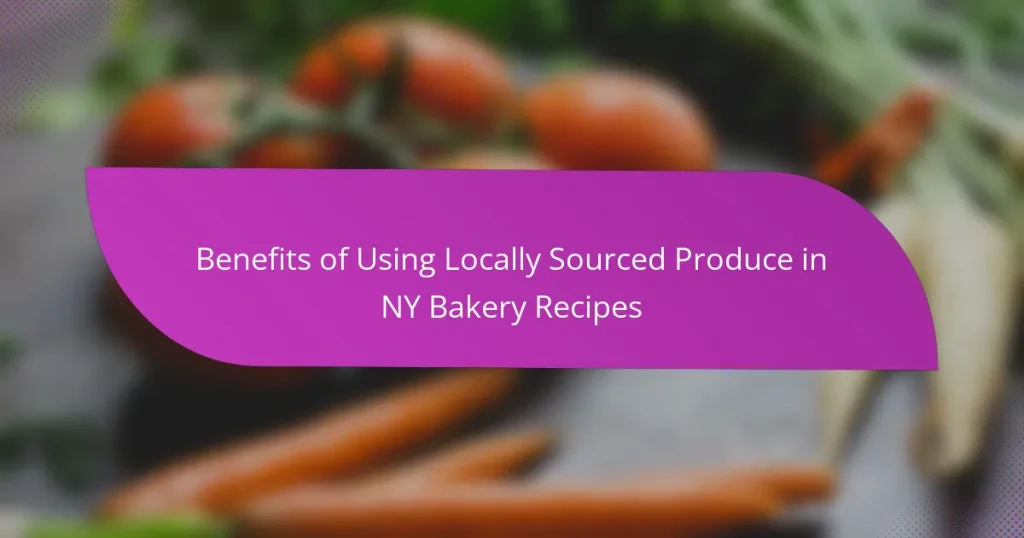Locally sourced produce significantly enhances the freshness and flavor of bakery recipes in New York. Ingredients harvested at peak ripeness provide superior taste compared to imported goods, while supporting local farmers and boosting the economy. Utilizing local produce also reduces transportation emissions, promoting environmental sustainability. Seasonal ingredients inspire creativity in recipe development and contribute to better nutrient retention, as studies indicate that fresh produce contains more vitamins and minerals. Overall, incorporating locally sourced ingredients is a beneficial choice for bakers, combining taste, sustainability, and health advantages.

What are the benefits of using locally sourced produce in NY bakery recipes?
Using locally sourced produce in NY bakery recipes enhances freshness and flavor. Local ingredients are often harvested at peak ripeness. This results in superior taste compared to imported goods. Additionally, locally sourced produce supports local farmers and the economy. It reduces transportation emissions, contributing to environmental sustainability. Seasonal produce encourages creativity in recipe development. Local sourcing can also lead to better nutrient retention. Studies show that fresh produce retains more vitamins and minerals. This combination of benefits makes locally sourced ingredients a valuable choice for bakers.
How does using locally sourced produce impact the freshness of bakery items?
Using locally sourced produce significantly enhances the freshness of bakery items. Local ingredients are harvested at peak ripeness, which maximizes flavor and nutritional content. This immediate availability reduces transportation time, ensuring that produce retains its freshness. For example, fruits and vegetables used in baking are often delivered within hours of harvest. This contrasts with imported produce, which may spend days in transit. Research indicates that fresher ingredients contribute to improved taste and texture in baked goods. A study published in the Journal of Culinary Science & Technology found that baked items made with local produce had higher consumer preference ratings for freshness. Therefore, utilizing locally sourced produce directly impacts the overall quality and freshness of bakery items.
What are the signs of freshness in locally sourced ingredients?
Freshness in locally sourced ingredients can be identified through several key signs. Vibrant colors indicate freshness, as dull or faded hues suggest age. Firm texture is another indicator; fresh produce should feel crisp and not soft or mushy. A pleasant, strong aroma signifies freshness, while a lack of scent may suggest it is past its prime. Additionally, minimal blemishes or imperfections on the surface is a sign of quality. Lastly, seasonal availability often correlates with freshness; ingredients that are in season are typically fresher than those that are out of season.
How does freshness influence the taste of baked goods?
Freshness significantly enhances the taste of baked goods. Fresh ingredients retain their natural flavors and aromas. This leads to a more vibrant and appealing taste profile. For instance, fresh fruits used in pastries provide a burst of flavor that older ingredients lack. Additionally, fresh herbs or spices can elevate the overall flavor complexity. Studies show that baked goods made with fresh ingredients often have improved texture and moisture. Local sourcing ensures ingredients are used at their peak freshness. This practice can result in a superior taste experience for consumers.
Why is supporting local farmers important for NY bakeries?
Supporting local farmers is important for NY bakeries because it enhances ingredient quality and freshness. Local produce often has superior taste and nutritional value. This is due to reduced transportation time, allowing ingredients to be harvested at peak ripeness. Additionally, supporting local farmers strengthens the local economy. When bakeries source locally, they contribute to the livelihoods of nearby farmers. This practice fosters community relationships and promotes sustainable agricultural practices. Research shows that locally sourced ingredients can reduce carbon footprints by minimizing transportation emissions. Overall, local sourcing benefits both bakeries and the communities they serve.
How does purchasing locally contribute to the local economy?
Purchasing locally contributes to the local economy by keeping money within the community. When consumers buy from local businesses, a larger portion of the revenue stays in the area. This supports local jobs and helps stimulate economic growth. Studies show that local businesses reinvest approximately 68% of their revenue back into the local economy. This can lead to a multiplier effect, where local spending creates further economic activity. Additionally, local purchasing fosters community relationships and strengthens the local supply chain. Overall, buying locally drives economic resilience and sustainability within the community.
What are the environmental benefits of sourcing produce locally?
Sourcing produce locally reduces carbon emissions associated with transportation. Local produce travels shorter distances, resulting in lower greenhouse gas emissions. This practice also supports sustainable farming methods. Local farms often use fewer pesticides and fertilizers, which benefits soil health. Additionally, sourcing locally promotes biodiversity. Diverse local crops can enhance ecosystem resilience. Furthermore, it conserves water by reducing the need for extensive irrigation. Studies show that local food systems can lessen food waste through better distribution. Overall, local sourcing fosters a healthier environment.
What nutritional advantages come from using locally sourced produce?
Locally sourced produce offers enhanced nutritional advantages. It is often harvested at peak ripeness, which maximizes nutrient content. Fresh fruits and vegetables lose vitamins over time, especially during transportation. Local produce typically has a shorter supply chain, ensuring greater freshness. Research indicates that fresh produce can contain higher levels of antioxidants and vitamins. For example, a study published in the Journal of Agricultural and Food Chemistry found that locally grown tomatoes had significantly higher vitamin C levels than those shipped long distances. Additionally, local farming practices may prioritize organic methods, reducing exposure to harmful pesticides. Overall, utilizing locally sourced produce in recipes can lead to healthier baked goods.
How does the nutritional value of local produce compare to imported options?
Local produce generally has higher nutritional value compared to imported options. This is often due to shorter transportation times, which can lead to fresher fruits and vegetables. Freshness typically retains more vitamins and minerals. For example, a study from the University of California found that locally sourced tomatoes can have 50% more vitamin C than those imported. Additionally, local produce is often harvested at peak ripeness, enhancing nutrient density. In contrast, imported produce may be picked early to withstand long shipping times, resulting in nutrient loss. Research indicates that nutrient degradation can occur within days of harvest. Therefore, local produce tends to provide better overall nutrition for consumers.
What specific nutrients are more abundant in locally sourced ingredients?
Locally sourced ingredients are often more abundant in vitamins, minerals, and antioxidants. These nutrients are typically higher due to shorter transportation times and fresher harvesting practices. For example, local fruits and vegetables can retain more vitamin C and other essential nutrients. Research shows that produce loses nutrients over time, especially during long transport. A study by the University of California found that local produce can have up to 50% more nutrients compared to those shipped from far away. Additionally, locally sourced ingredients often have higher levels of phytochemicals, which contribute to overall health benefits.
How can local produce enhance the uniqueness of bakery recipes?
Local produce can enhance the uniqueness of bakery recipes by introducing distinct flavors and textures. Ingredients sourced from nearby farms often reflect the local climate and soil, resulting in unique taste profiles. Seasonal fruits and vegetables can inspire innovative recipes that showcase these flavors. For example, using local apples in pies can create a fresher, crisper taste compared to imported varieties. Additionally, local grains can provide unique textures and nutritional benefits. Bakeries that use local produce can also foster community connections and support local economies. This practice can lead to a more sustainable approach to baking, appealing to environmentally conscious consumers.
What are some creative ways to incorporate seasonal local ingredients into recipes?
Incorporating seasonal local ingredients into recipes can enhance flavor and support local agriculture. Use fresh fruits and vegetables in baked goods, like zucchini bread with local zucchini. Create seasonal jams or preserves for pastries using local berries. Experiment with herbs from local farms to add unique flavors to bread and cakes. Utilize seasonal nuts in granola or cookies for added texture. Incorporate honey from local beekeepers as a natural sweetener in various recipes. Feature local dairy products in frostings or fillings for a regional twist. Highlight seasonal ingredients in daily specials to attract customers and celebrate local produce. These methods not only elevate recipes but also promote sustainability and community support.
How does using unique local flavors differentiate a bakery’s offerings?
Using unique local flavors differentiates a bakery’s offerings by creating distinct products that resonate with the community. These flavors often reflect regional ingredients and culinary traditions. Incorporating local flavors can enhance the freshness and quality of baked goods. For example, a bakery using local honey or seasonal fruits can offer unique taste experiences. This approach can foster a strong connection with customers who appreciate local sourcing. Furthermore, it can boost the bakery’s brand identity, setting it apart from competitors. Studies show that consumers are increasingly favoring businesses that prioritize local ingredients. This trend indicates a growing market for locally inspired baked goods.
What challenges might bakeries face when sourcing produce locally?
Bakeries may face several challenges when sourcing produce locally. Limited availability of seasonal produce can restrict options for ingredients. Quality and freshness can vary depending on the supplier. Transportation issues may lead to delays in receiving products. Price fluctuations can make budgeting difficult for bakeries. Additionally, establishing reliable relationships with local farmers requires time and effort. Compliance with local regulations can also pose challenges. These factors can impact the overall efficiency of sourcing locally.
How can bakeries overcome seasonal availability issues?
Bakeries can overcome seasonal availability issues by establishing relationships with local farmers. This allows them to source fresh ingredients throughout the year. By planning their menus around seasonal produce, bakeries can utilize ingredients that are readily available. This approach not only enhances the flavor of baked goods but also supports local agriculture. Statistics show that using locally sourced ingredients can reduce supply chain disruptions. Moreover, bakeries can preserve seasonal fruits and vegetables through canning or freezing. This method ensures availability during off-seasons. Additionally, bakeries can diversify their product offerings to include items that require less seasonal produce. This adaptability can help maintain consistent sales year-round.
What strategies can be implemented to build relationships with local farmers?
To build relationships with local farmers, bakeries can implement several strategies. First, establishing regular communication is essential. This can include phone calls, emails, or in-person visits to discuss needs and expectations. Second, participating in local farmers’ markets fosters direct connections. Engaging with farmers at these events creates trust and collaboration. Third, offering fair pricing for produce ensures mutual benefit. Fair compensation encourages farmers to prioritize your bakery’s needs. Fourth, collaborating on promotional events highlights both the bakery and the farmers. Joint marketing efforts can attract customers to both parties. Lastly, providing feedback on produce quality helps farmers improve their offerings. This two-way communication strengthens relationships over time. These strategies create a supportive network that benefits both local farmers and bakeries.
What best practices should bakeries follow when using locally sourced produce?
Bakeries should prioritize freshness and seasonal availability when using locally sourced produce. This ensures optimal flavor and quality in baked goods. Establishing relationships with local farmers promotes trust and reliability in sourcing. Regularly visiting farms can provide insights into growing practices and product availability. Implementing a farm-to-table approach enhances transparency and customer engagement. Utilizing produce quickly reduces waste and preserves quality. Educating staff about the benefits of local ingredients improves product knowledge. Lastly, marketing locally sourced items can attract customers interested in supporting local agriculture.
How can bakeries effectively market their use of local ingredients?
Bakeries can effectively market their use of local ingredients by highlighting their sourcing practices. They should prominently display information about local farms and suppliers on their menus and websites. Engaging storytelling about the origins of ingredients can create a personal connection with customers. Utilizing social media to showcase local partnerships can enhance visibility and appeal. Bakeries can also offer seasonal products that reflect local harvests, attracting customers interested in fresh, community-driven options. Participating in local farmers’ markets can further reinforce their commitment to local sourcing. Research indicates that 70% of consumers prefer businesses that support local communities. This preference can drive sales and customer loyalty.
What tips can help ensure quality when sourcing from local suppliers?
To ensure quality when sourcing from local suppliers, establish strong relationships with them. Good relationships foster communication and transparency. Assess the supplier’s reputation through reviews and references. This helps identify reliable sources. Conduct site visits to evaluate the supplier’s operations and quality controls. Observing practices firsthand provides insight into their standards. Request samples of products before committing to larger orders. Testing quality in smaller quantities helps mitigate risk. Lastly, maintain regular communication to address any concerns promptly. Consistent dialogue ensures quality expectations are met.
The main entity of this article is locally sourced produce in bakery recipes. The article outlines the benefits of using locally sourced ingredients in New York bakeries, highlighting enhancements in freshness, flavor, and nutritional value. It discusses the positive impact on the local economy and environmental sustainability, as well as the importance of supporting local farmers. Additionally, the article provides insights on how to identify freshness, the influence of local produce on taste, and strategies for bakeries to effectively source and market these ingredients. Key challenges and best practices for maintaining quality when sourcing locally are also addressed.




